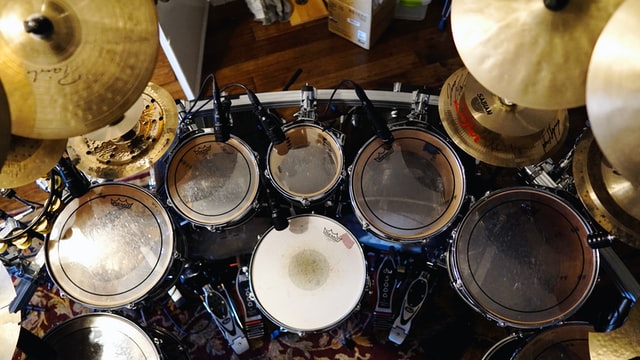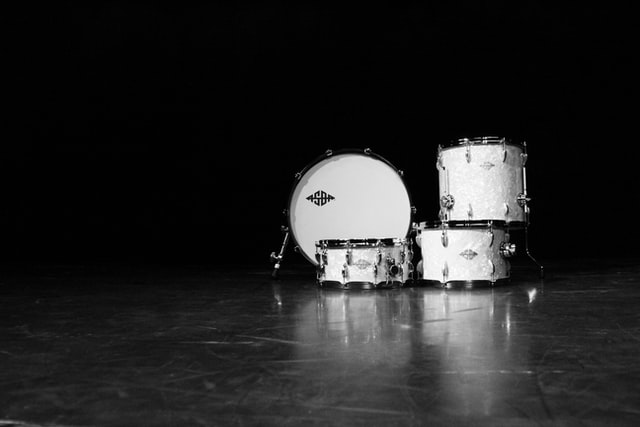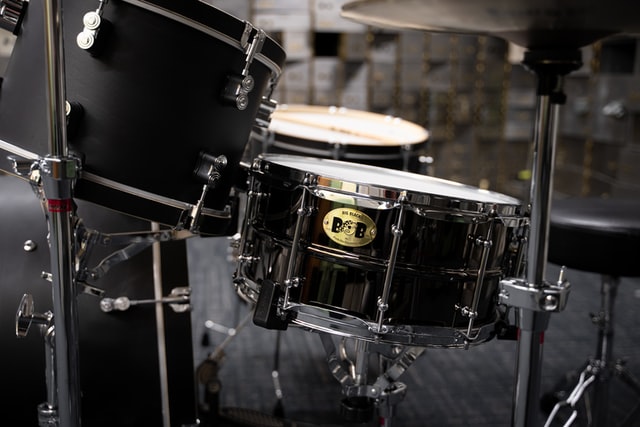Drums are the world’s oldest and most widely used musical instruments, with a fundamental design that hasn’t altered much in thousands of years.
Kick drum, snare drum, and tom-toms have a similar structure and consist of three main elements:
- Drumhead
- Shell
- Hardware
We will show you how each part of the drum is made, so you can know your instrument better.
Additionally, we will briefly introduce you to the manufacturing cymbals since they are an important part of your drum kit.
Let’s dig into how to make drums.
The drumhead

The drumhead of a drum is a membrane stretched over a drum shell. It used to be made of animal skin in the old times, but now it’s made of plastic.
The specific type of plastic used for making drum heads is called polyethylene terephthalate, a combination of terephthalic acid and ethylene glycol.
These chemicals are warmed up until they become liquid plastic. Afterward, the liquid plastic is cooled on a large metal roller until it becomes solid.
The solid plastic is then stretched between smaller metal rollers to produce a thin film. Films can be created in a wide range of colors, transparent or opaque, by adding various additives to the mixture.
Since the drums come in different shapes, the film is cut into circles of the proper sizes with precision cutting tools.
A heating element later softens the circle’s edge to form a collar around the circumference. The last thing to do is place a steel ring within the collar and an aluminum ring outside the collar and close them with a rolling machine.
Usually, the big companies make rolls of membrane film, and individual manufacturers cut them and make further steps to assemble them into drums.
The shell

The shell provides the structure of the drum, and it’s usually made from wood or metal.
The metal shells are made by pouring molten metal into a mold in the shape of the shell or by shaping the metal with drills and lathes.
Wooden shells are the most common. They are made from large, thin wooden panels called veneer. A computer-controlled saw cut the veneer to the proper size to make the shell.
After that, pieces of cut veneer are moved through a glue press.
7-9 layers of veneer are then rolled together to form a cylinder and inserted into a metal mold of the proper size to make the desired shell.
The finished shells can be covered with decorative plastic or stained with colors and a shiny topcoat.
Hardware

Besides drumheads and shells, drums need other components to be assembled.
The hardware of drums is what keeps all parts together, and it’s consisted of:
- Rim
- Tuning screws
- Lugs
Small holes are drilled into the shell using precision drills, allowing the hardware parts to be securely attached.
Rim
The rim, or the hoop, keeps the head of a drum in the place, tightly secured around the shell.
It can be made of metal, wood, or other materials.
Bolts through metal “claws” affixed directly to a hoop or through holes in a flanged or die-cast rim secure a drumhead to a drum shell.
Tuning screws
Tuning screws, also known as tension rods, are screws that are usually made of metal and placed around the rim.
They pass through the aluminum ring surrounding the head and into the lugs.
You can tighten or loosen the head and change its tone and pitch with them.
Lugs
Lugs are large bolts that keep the tuning screws in place and are attached to the drum shell.
Tension rods are put into threaded lugs to tighten and tune the drumhead.
The tension rods can be screwed into the lugs with a special type of wrench called a drum key.
Other hardware
Some drums require additional hardware.
The kick drum needs legs called spurs on either side of the drum shell to prevent the drum from rolling around.
Snare drums have pieces of curled wire that reverberate, stretched across the bottom head held by the strainer on both ends. Snare drums, tom-toms, as well as cymbals, require stands to be part of the drum kit.
The stands are usually made from metal and can be adjusted to the desired height. Of course, the last but not least part of the equipment are drum sticks, which can vary in size and shape, and a bass pedal for the kick drum.
Cymbals

Cymbals are made in a different way and from a different material than drums, and we will briefly walk you through their manufacturing process.
Cymbals can be made from different mixtures of metals or alloys.
There are four main alloys, all of them copper-based:
- Bell bronze
- Malleable bronze
- Brass
- Nickel silver
There are three stages in the process of making cymbals:
- Casting
- Hammering
- Finishing
At the beginning of the manufacturing process of cymbals, metal alloys are melted and poured into a geometric-shaped mold.
After cooling down, the cymbal is treated with presses and other tools until it gets an accurate shape. The hammering process is essential since it affects the sound of the cymbal.
The cymbal can be hand-hammered, but nowadays, hammering can be done with a computer-controlled machine. The last steps are cutting and shaping, polishing, and logo printing as a final step of the process.
Wrap-up
Getting to know your equipment is one of the most important things you need to do as a drummer.
The main parts of drums are the head, shell, and hardware that hold the parts together and enable tuning of the drums, such as rim, tuning screws, and lugs.
Each of these parts is usually produced by a different manufacturer and then assembled into the final shape by the drum makers.
While kick drum, snare, and tom-toms have very similar structures, cymbals are made in different manufacturing processes, including casting, hammering, and finishing.
If you want to know more details about how the drums are made, check out the story about our peak inside Yamaha’s factory.
